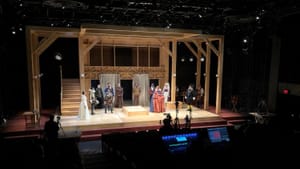Stay in the Loop
BSR publishes on a weekly schedule, with an email newsletter every Wednesday and Thursday morning. There’s no paywall, and subscribing is always free.
Quarantine has never killed theater, and it’s not about to
Theater artists are at work during the COVID-19 lockdown. Here’s how—and where to find them

When I drove to People’s Light on March 12 to see another performance of Shakespeare in Love and lead a post-show discussion as the production dramaturg, I did not know that it was one of my last chances to see theater with a live audience for the foreseeable future. Within the hour, People’s Light announced the wise decision to cease all public performances and go dark due to the spread of COVID-19. But once the news broke that Broadway was shutting down, it was inevitable that theaters around the country would have to make the same sacrifice.
An ineffable ache
It’s not easy to give words to the disappointment and the ache that accompany closing a show prematurely or never seeing it take off in the first place. I lived with Shakespeare in Love for a long time—from engaging in the play’s first rounds of reading for season selection in 2018 to the opening night in late February 2020. I spent long nights pulling articles for actor packets and dyeing sonnets to hang for the public lobby display. But most importantly, I bore witness to the vigor and skill of our actors and musicians, the care of our intimacy director and fight choreographer Eli Lynn, the artistry of our designers and composer Alex Bechtel, the playful guidance of our director Matt Pfeiffer, the steadfastness of our stage management team and crew. I saw their hard work, and then I saw their creation robbed of its full life.
On top of the creative loss, most artists are now facing indefinite unemployment, economic uncertainty, and loss of healthcare (if they even qualified for healthcare through unions like Actors Equity in the first place). The future of theater non-profits of all sizes is uncertain as they await to see how long they must keep their doors closed to patrons.
Plays and the plague
Many people have been quick to point out that past epidemics have been a useful catalyst for creativity. If I had a dollar for every time someone this week mentioned Shakespeare’s writing renaissance during the plague…
“The theater, I have always maintained, is composed of language, ether and actor,” playwright Sarah Ruhl wrote recently in her New York Times opinion essay. “One commodity the theater has that film and television do not have is air. Air is that wonderful substance that denotes presence...” Theater’s art form boils down to a pretty simple formula: story + storyteller + audience = theater. Without the presence of an audience breathing with us, what happens to our industry?
There are already websites like BroadwayHD and organizations with digital libraries like PBS’s Great Performances franchise that allow folks to enjoy theater from their couches. The Metropolitan Opera, in a show of generosity, is giving access to their Live in HD encore performances free of charge and will be streaming a different opera each night. But how does art that has yet to be produced or that shut down mid-run continue to be witnessed when we’re staying home in an effort to save lives?
As always, artists find a way.
Companies rally
Within a few days of the growing shutdown, artists and organizations across the country have mobilized and taken to virtual platforms to keep theater-making alive and available to eager audiences.
When People’s Light leadership let us know that Shakespeare in Love would not continue live performances, they also revealed that they got permission to film the production so that ticketholders could have a chance to see the show. Once the footage is ready, folks will get a time-sensitive link and a password, and then with one click they can see our team’s months-long efforts. Our production will have a continued life, if not in the way we imagined it. Theatre Horizon has also launched digital programming via its YouTube channel, providing a way to give its artists and educators work and continued payment as they keep content flowing from their company (look for content to go live the week of March 23).

“Theatre Without Theater” and more
Individual artists are also answering the call. New York City-based artists Lily Houghton, Matthew Minnicino, and Ali Stoner created the Instagram account Theatre Without Theater, urging artists to submit material for them to stream nightly at 7:30pm (a common curtain time). Recent nights have featured Emily Walton (Roundabout Theatre Company’s Darling Grenadine) and Margot Seibert (Unknown Soldier at Playwrights Horizons) each singing a song from their respective shows (both closed early). Director Sammi Cannold spoke on the platform, relaying that playwright Celine Song would share the New York Theatre Workshop’s Endlings script to anyone who would send Cannold a direct message. Students from the UMN/Guthrie BFA Acting program put out a “Quarantine Playwriting Bake Off” call. Using playwright Paula Vogel’s exercise, writers are given five “ingredients” and then have 32 hours to write a new short play. Winners of the bakeoff will have their pieces read on YouTube Live.
Locals firing up
Philadelphia artists are also creating platforms for themselves and others, serving folks who hunger for the kind of connection performance (even if experienced virtually) can provide. Over the weekend, Bearded Ladies favorite Eric Jaffe hosted a virtual drag performance at brunch time using Facebook Live (hopefully if we beg enough, there will be more of these drag brunches to come). Local actors with solo performances are brushing up material for the same platform. Singers, like Shakespeare in Love’s own Pax Ressler, are giving sneak-peek concerts of albums that they are releasing—giving us a moment of melodies instead of medical news. Philly horror maven Josh Hitchens has been live-streaming his own spooky creations on Facebook.
And buckle up, because there’s a schedule of live local streaming options from Philly artists exploding on Facebook (currently featuring work from Tuesday, March 17, through Sunday, March 22). You may not be breathing the same air as the person next to you and shivering or laughing or crying together, but these digital options are a communal fireplace.
Within our power
At the end of Shakespeare in Love, when Shakespeare is in the throes of imagining Twelfth Night; Or What You Will, he says that his heroine Viola “is the spirit of freedom, of true love trying against all bounds to be out.” Like his Viola, artists are proving once again that quarantines and pandemics cannot contain love and art.
This wave of virtual art is not only a balm for growing loneliness caused by self-quarantine—it’s a means for lovers of live performance to support creators and performers who are continuing to put themselves out there for our collective fulfillment. Shakespeare may have written King Lear when theaters were shut down during the plague, but you better believe he still got paid for it thanks to royal funding by King James I. And with digital patronage platforms, such as Venmo and Patreon, there are still ways for artists to make a living when everyone’s trapped at home. Whether you donate to local companies you love, or send funds to individual artists when you watch their digital streams (or both? Do both?), it is within your power to keep art alive in the age of coronavirus.
Sign up for our newsletter
All of the week's new articles, all in one place. Sign up for the free weekly BSR newsletters, and don't miss a conversation.
 Alix Rosenfeld
Alix Rosenfeld